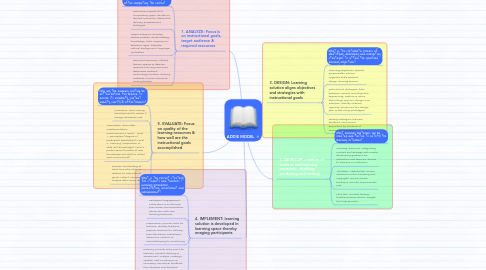ADDIE MODEL
by Cheyenne McClarthy

1. 1. ANALYZE: Focus is on instructional goals, target audience & required resources
1.1. What should students already know and what should they know after completing the course?
1.2. Instructional goals: find competency gaps, decide on desired outcomes, determine delivery & assessment strategies
1.3. Target audience: develop learner profiles, check existing knowledge, skills, experience, behavior, ages, interests, cultural background, language, motivation
1.4. Required resources: identify learner spaces & devices, research learning resources, determine content, technology, facilities, delivery methods, human resources, limiting factors
2. 5. EVALUATE: Focus on quality of the learning resources & how well are the instructional goals accomplished
2.1. How will the learning solution be vetted before full release to ensure its reliability, content validity, clarity & effectiveness?
2.2. Formative: done during Development to assure if Design standards met
2.3. Summative: done after iImplementation, measurement 3 levels - Level 1- perception [degree of participant satisfaction]; Level 2 - learning [ acquisition of skills and knowledge]: Level 3 - performance [transfer of new knowledge and skills to actual work environment]
2.4. Process: final testing of what-how-why-when in relation to instructional goals, collect, interpret & analyze data, share results
3. 4. IMPLEMENT: learning solution is developed in learning space thereby enaging participants
3.1. What is the roll-out strategy for students and teachers including procedures, presentation, assessment and enhancement?
3.2. Participant engagement: notification & enrollment, pre-course communication, interaction with new learning resources
3.3. Preparation: provide tools for learners, identify teachers, prepare teachers for delivery, train-the-trainer workshops, determine method of record-keeping for monitoring
3.4. Delivery: provide entry point for learners, conduct delivery & assessment, analyze, redesign, update, edit or enhance as necessary, emotional feedback from learners and teachers, back-tool in case of failure (technological, etc.)
4. 3. DEVELOP: creation of content and learning materials - drafting, producing and testing
4.1. What learning materials will be created and tested to satisfy the learning outcomes?
4.2. Learning resources: integrating content and strategy with media; developing gudiance for instructors and learners, decide to insource or outsource,
4.3. Validation: stakeholder review, revisions,confirm licensing and copyright, ensure access, backup & security requirements met
4.4. Pilot test: conduct testing, feedback/observations, insight, final adjustments,
5. 2. DESIGN: Learning solution aligns objectives and strategies with instructional goals
5.1. What is the systematic process of identifying, developing and evaluating strategies to attain the specified learning objectives?
5.2. Learning objectives: specific measureable actions, cognitive skills needed, design learning spaces
5.3. Instructional strategies: links between content and objective, sequencing, explore & refine technology opyions, design user interface, identify network capacity, storyboard the design, plan & test using prototypes
5.4. Testing strategies: learners, feedback mechanism, acquisition by students of desired competences


